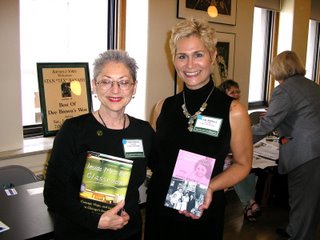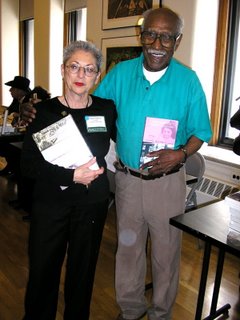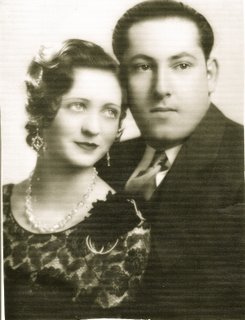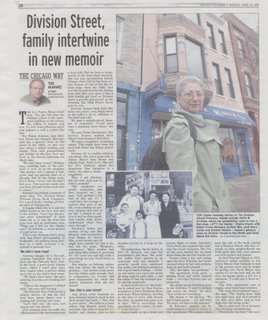Tom McNamee
Division Street, family intertwine in new memoir
April 10, 2006
BY TOM McNAMEE SUN-TIMES COLUMNIST
This is a Puerto Rican street now. You can tell from the brilliant yellow of the apartment building on the corner, the yellow of islands and rum. No Jew from a Russian shtetl ever painted a wall a yellow like that.
For Elaine Soloway, how Division Street has changed. Her parents ran a grocery store on the street in the 1940s, on this very spot where a yellow building now stands. They sold pumpernickel and brisket on the first floor and lived on the second, bickering the whole time.
"We had three rooms," Soloway says, standing back on the sidewalk to look up at the windows. "My brother and I shared a bedroom, and our parents slept on a Murphy bed in the living room. It's a cliche, I know, but we didn't feel poor. Your parents made sure you were fed and clothed and went to school."
Soloway has written a memoir of those days, The Division Street Princess (Syren Book Company). It's a good book, a loving yet honest slice of Chicago life.
It begins when she is 4 and her father bursts in the door and says to her mother, "Let's buy the grocery store downstairs!" It ends when she is 13 and the store has gone bust and an auctioneer says, "What am I bid for the display case?" In between, a smart peanut of a girl grows up.
This is why Soloway and I, along with Sun-Times photographer Al Podgorski, are walking along Division on a chilly morning. I requested a personal tour.
'We didn't have trees'
Soloway charges off to the east, crossing Campbell. She wants to show me the Deborah Boys Club. In her book, a particularly intense scene, which I won't give away here, begins when a pervert sidles up to her on the club's front steps.
"We didn't have trees," she says, pointing at a tree, not breaking her stride.
"This is the lamppost I collided with," she says, still moving.
The Deborah Boys Club is now a church. Maybe. Or was the club next door, where there's now a parking lot? Soloway isn't sure.
"Let's find out," she says, and swoops into the church.
Ten minutes later we walk out, still not sure if the church was ever a boys club. But we leave a receptionist at the front desk charmed. She has just encountered Jewish Chicago circa 1945 in the form of a tiny woman so full of life she almost sings when she talks. And now the receptionist knows, having been told, that once upon a time a little Jewish girl lived on Division above a grocery and played on the sidewalk, like little Puerto Rican girls do now.
Soloway charges back west. She talks and points, even twirls about as she takes it all in, oblivious to the wind and cold.
We pass a neighborhood chamber of commerce. "Could have been a hardware store there," she says.
We pass Paseo Restaurant. Her brother, Ronnie, worked there when it was Sammy's Red Hots.
We pass a pregnancy counseling center. This might have been the pool hall where her father played cards.
Soloway, 67, is a public relations consultant. She was a press aide to former Mayor Jane Byrne and schools Supt. Ruth Love. She and her first husband raised two daughters. One daughter is a writer, the other a singer-songwriter.
Why, I ask Soloway, did she wait until now to write a memoir?
"My daughters are pretty audacious, and they inspired me," she says. "And perhaps I felt that at this age, 67, I could have the courage to explore that part of my life. I was missing my parents, missing that part of my life. I wanted to capture it and be there again. And maybe, now, better understand what they went through."
Soloway's father and mother, Irving and Min Shapiro, were immigrants from Russia. Irv adored Min, a real beauty, and all might have turned out fine if she had felt the same. "Romance, schamance," Min's mother had said when Min balked at marrying Irv. "Irv loves you and will make a good living for you. You'll learn to love him."
But maybe, as Soloway writes, that was always the heart of the problem -- her mother could never love her father quite enough. And, to compensate, he overate and grew dangerously fat, while she quietly wondered what she had missed.
'See, this is your street'
Just about every business we pass, Soloway wants to duck in and show people her book -- "See, this is your street." She talks to a bank officer, Dan Brandt, about long-lost delis. She talks in Spanish to a barber and dances, just a few shoulder moves, to a song on the radio.
The barbershop, Sportz Kuttz, at 2653 W. Division, was once her grandfather's fish shop. Her zadie and bubbie lived upstairs in an apartment with bay windows. I probably should have mentioned this earlier, but Soloway's memoir is full of good family feelings -- brothers and sisters and aunts and uncles all doing right by each other -- and the center of that big extended family was this apartment.
As luck would have it, the building is owned now by Stan Kustra, proprietor of Joe's Hardware Store next door. When Soloway, blowing in the door at Joe's, tells Kustra her story, he smiles and grabs a set of keys. "We're renovating that apartment, so it's empty," he says. "C'mon, let's go."
Kustra leads us up a steep and narrow flight of stairs. Soloway's Uncle Paul once painted this staircase the nicest turquoise. Her Uncle Hy once carried her up these stairs when she had her tonsils out.
Kustra turns a key and swings open the door. Soloway, her hands jammed down in her coat pockets, steps in and looks around.
"Oh," she sighs, "my goodness."
The apartment looks good -- shining floors and newly painted walls -- but what Soloway sees are memories.
She glides across the living room to the windows. "I used to sit here and watch the street," she says. "You could see everything."
She moves to the kitchen. "We had a back porch -- it's still here! We slept out here in the summer."
In Soloway's memoir, my favorite scene is a Passover dinner in this apartment. The scene comes near the end of the book, closing out a Division Street tale that reminds us that neighborhoods are both good and bad, and parents are both perfect and human.
At that Passover dinner in 1952, Soloway's father confides to her Uncle Maury that business is bad at the grocery store and he might be getting out. Uncle Maury says maybe it's for the best and, by the way, he knows about a job for a salesman. "I could put a word in," he says.
This little apartment, now so empty, must have been crowded.
"Oh, yeah, but it seemed bigger," she says. "The dining room table was right here, and we'd extend it out with card tables, end on end, right into the living room."
She is quiet now for a moment, just thinking, remembering.
"Everybody was here," she says.






